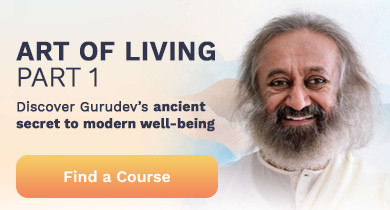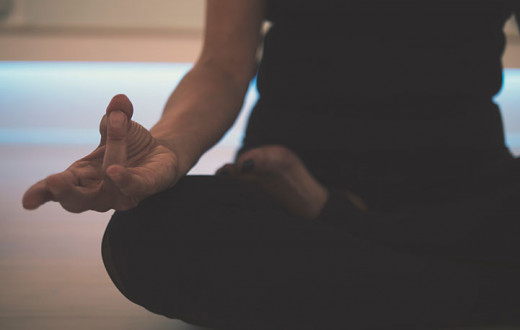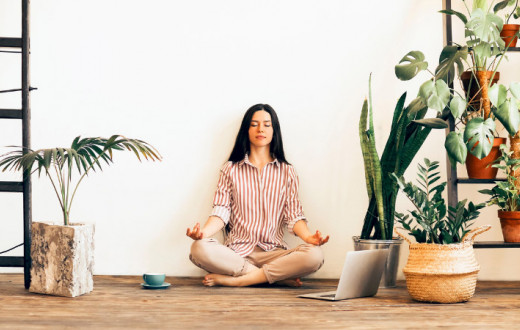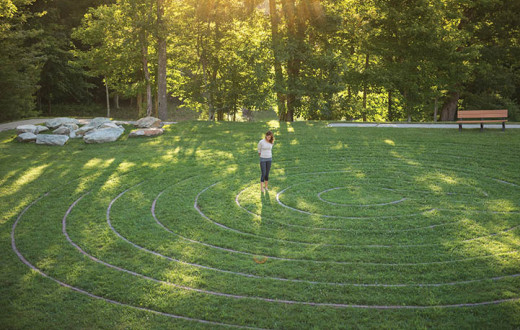
Whether you are trying to help your fidgety eight-year-old child to sit down and focus, or attempting to counsel your emotional teenager to communicate respectfully, meditation can help shift them to more calm and clarity. There are several research-backed benefits of meditation that can help your child to feel calmer and better regulate their emotions. Meditation is key to unlocking more potential, so they can thrive and grow up well-balanced.
There’s a whole world of meditation for kids to explore— practical benefits, short meditation techniques for children and teens, and some tips to make meditation more child-friendly.
Benefits of meditation for your kids
With meditation, your child’s inner joy can express itself more freely. A child’s innate nature is beautiful and joyful. In this state, children are relaxed, calm, and energized in a balanced way.
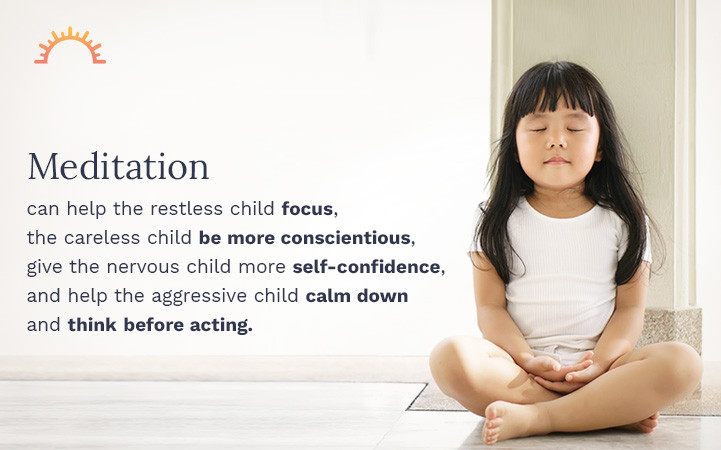
Meditation can help the restless child focus, the careless child be more conscientious, give the nervous child more self-confidence, and help the aggressive child calm down and think before acting. So, it naturally follows that parents should take advantage of this simple tool for their children and especially teenagers, who are often on an emotional roller coaster, feeling the pressure of school and college apps, and learning to navigate relationships.
Perhaps the burning question in your mind at this point is, “How do I get my child/teen to meditate?!? She/he doesn’t want to.” We get it! Meditation can seem like a hard sell! So, we have come up with some simple techniques to help you broach the Big ‘M’ with your child or children. We have included helpful tips as well as breathing exercises and guided meditations. We’ve divided the information into two groups, one section for the younger 8 to 12-year age group and the other for the more mature teenagers.
Pro tip: Keep it short and simple
20 minutes of meditation might be tedious and tiresome for children. You will definitely encounter a few stumbling blocks if you try to force them to sit so long. Moreover, even if you manage to tie them down the first time, the chances that they will pry themselves loose are high. And, worse, you will find it difficult to approach them a second time as they will not indulge you again.
Here the keyword is ‘short’. Ask them to meditate for 3-8 minutes. You will find that short meditations for kids are easier and more effective.
If you have a teenager at home who is ready for slightly longer sessions, you can try this guided meditation with Art of Living Founder, Gurudev Sri Sri Ravi Shankar.
Short meditation techniques for kids of all ages
1. Observe your breath as if it was your best friend
One way to start meditation for your children is to ask them to close their eyes and breathe in and out slowly. And just observe the breath for 2-3 minutes.
2. Relax facial muscles that have been exposed to long screen hours
Increased screen time for children has made Sukshma Yoga, a simple yoga technique for relieving tense facial muscles, absolutely necessary. How often do we pay attention to our senses that work continually day in and day out for us? No better time than now to stretch, knead, and gently massage the face, eyebrows, ears, mouth, chin, and cheeks. It can be just the warm-up exercise required to energize children before classes.
3. Breathe your way into meditation with breathing exercises
After a good physical session outdoors children usually come home tired. Sometimes, they are upset because they have had a disagreement with their friends or they are moody because, well, kids are kids! At this time, give them your full attention. Ask them to wash up and sit down with you. To help them get over their feelings of conflict and exhaustion, ask them to close their eyes, and take deep breaths.
Once they are sitting, ask them to do the Bhramari Pranayama. This is a fun breathing technique where they make a sound like a bee buzzing while placing their fingers on their ear cartilage. It looks like they are plugging their ears and might make them laugh a little. The pleasant vibrations that they experience will help them calm down and go within almost instantly.
Another great breathing exercise that will help children get over their weariness is the Bhastrika Pranayama (Bellows Breath). This exercise will not only get rid of exhaustion but also energize your child with renewed mental clarity. This technique can be learned on the SKY Youth Programs for kids and teens or during Beyond Breath, an introduction to breath and meditation for adults.
4. Whisper before meditation
If your child is especially loud and enthusiastic, try whispering before you want them to meditate. If you whisper softly rather than raise your voice so they can hear you, they are likely to notice they cannot hear you. Usually, that leads to them asking, “What?”, in a loud or normal tone. Continue whispering and say, “I cannot hear you.” In their confusion, they usually start lowering their voice. I like to keep the whispering going right up to a short, silent meditation.
If you or your teen takes a SKY program/course, you learn a breathing technique closely related to whispering called Ujjayi or ocean breath. It is a great tool for meditation!
Simple 5-minute meditation techniques for kids
With eyes closed, ask them to take a deep breath, and say Om aloud as they release their breath simultaneously.
Young children love a good challenge. Simple sun salutations are just perfect for them. They could start with one or two rounds and then gradually increase to 6. Ask them to lie down for 5-10 minutes after that. You could also add Yoga Nidra guided meditation for a slightly longer session.
Jumping is part of children’s daily movements. Ask them to do some jumping and hopping exercises, or dance, and then FREEZE! And then, sit still for two minutes.
Take them out into nature, ask them to gaze at the sky, or the greenery around them in quiet reflection. You could also ask them to notice the different elements present in nature.
Pro tip: Ask your child to meditate after some physical exercise
It is important that children engage in physical exercise. Encourage them to play sports or do yoga asanas (postures) or even animal yoga. This will help them utilize their physical energy and help them be less restless. You will find them ready and willing to listen and sit in one place when they are tired.
Note: For the 8 to 12-year-old age group, pranayamas (breathing exercises) are as good as meditation. Ask them to do the breathing exercises for 5 minutes in all.
Note: For 13 to 18-year-olds, you can ask them to sit for a short guided meditation.
Pro tip: Approach your child through their friends
Children are very impressionable, and the impressions, more often than not, are of their friends and peers. Your kids are more likely to meditate if their friends also do it. So, you can ask their meditating friends to give an honest account of how meditation helps them. Sometimes, it helps to just give examples of friends who meditate. They might agree to meditate simply to not be left out! Also helpful is mentioning sports stars and other well-known celebrities who meditate. Meditation is instantly cooler if someone they admire also practices meditation.
Participate in group meditations
Children, especially teens, tend to gravitate to their friends. So, the best way to get your child to meditate is to do it in groups.
For 8 to 12 year-olds, you could try 30-minute play sessions with 10 minutes dedicated to yoga and meditation. You will likely hear a few giggles and spy a few peeks Doing it regularly will make this practice a part of their daily routine. It becomes a natural extension of their favorite activities.
Pro tip: Too tired to meditate, try Yoga Nidra
Sometimes, children are so tired after their playtime that they don't want to even sit upright. In such a case, what if they could lie down and meditate? Many kids find this easier to do as it is relaxing and effortless. A great meditation for kids when they are tired and want to lay down is Yoga Nidra meditation. Even if they fall asleep, it is ok. They can continue meditating once they have had enough rest. They might discover that resting with awareness is even more relaxing than sleep. You are unlikely to come across resistance from any age group for this mediation!
Special guided meditations for teenagers (13 to 18-year-olds):
Guided meditation to stop overthinking
One of the biggest obstacles to meditation is the concept that there are too many thoughts to meditate. Like monkeys jumping on the bed, it can seem overwhelming to try and control your thoughts. Teens can be especially good at overthinking.
In this guided meditation, Sri Sri effortlessly leads your teen into less and less thoughts and can even help with overthinking outside of meditation.
Transforming emotions guided meditation
The teenage years are full of emotional highs and lows. , With new hormones, bodies, situations and expectations, they are constantly working to adjust to their expanding physical and mental selves. It is a time in their life when their emotions confuse them, and their bodies undergo enormous changes.
This guided meditation can help to transform extreme emotions, and bring them to a stable and positive space.
Pro tip: Post meditation activities
As soon as your children are done with their meditation practice, let them engage in some creative pursuits like painting or writing. Or if homework was stressing them out, it is a great time to study and return to pending homework.
The left and right sides of the brain
The left side of the brain is responsible for logic, analysis, and order while the right side is responsible for creativity, arts, and intuition. Meditation helps you strike a balance between both sides. So, you are able to be imaginative and intelligent at once!
Post-meditation, children are able to sift through the mental clutter and find their creative side. Some kids find the results spilling onto their canvas. See if yours is one of them! If they are, you won’t have to thrust it into their schedule and endlessly remind them to practice. They will want to meditate on their own.
Another immeasurable benefit of meditation is that you will find that your interactions have less conflict and more cooperation. Your communication and connection with your kids will become stronger than ever before – a priceless benefit, wouldn’t you say?
For more on how to meditate read this article.
SKY Breath Meditation for you and your family
SKY Breath Youth Programs offer holistic wellness programs supporting emotional and physical wellbeing for students 8-17 years old. To learn more about what your child/teen will learn, you can learn some of the same techniques through the SKY Breath Meditation course. Both the youth programs and the course for adults teach SKY Breath Meditation, though instructions for youth are different. Here are some of the many benefits SKY practitioners report, and research has verified:
Greater mental focus
Increased emotional empathy
Significant reduction in depression
Significant reduction in anxiety
Enhanced deep sleep
Reduced impulsive behaviors
Increased self-esteem and joy
Once you experience SKY and all of its benefits you will want your whole family to practice SKY!
Learn more at a free breath and meditation online session. Just click the image below and choose a day and time that works best for you!
Written with inputs from Shreya Chugh, Faculty, Art of Living Foundation

